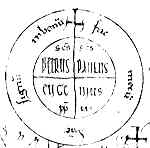



![]()


If you are looking at this page without frames, there is more information about medieval writing to be found by going to the home page (framed) or the site map (no frames).
| Papal Bulls (2) | |||
| Papal bulls became graded into different classes of document. The most weighty and significant, sometimes called privileges, can be equated with the solemn diploma. These bore the full elaboration of calligraphic scripts, symbols and wording. Their seals were attached with silk cords. | |||
 |
Bull of Pope Eugenius III of 1147 (British Library, Cotton Cleopatra E.1, f.123). It is for the benefit of the abbey of St Mary at Saltrey, tasking it into protection and confirming its possessions. (From New Palaeographical Society 1904) | ||
| Without even being able to read this document, one can see certain formal qualities of the solemn papal privilege. There is an exaggerated and compressed heading. The body of the text is followed by the circular sign manual and the Bene Valete monogram. Below that are three columns of signatures of cardinals who have witnessed the document. At the bottom is the date and name of the chancellor. The lead bulla, or seal, is lost. | |||
 |
 |
||
| The elongated heading has become extremely stylised. Abbreviation marks here and in the body of the text are in the form of the curly mark known as the papal knot. At the end of the heading is the formula IN PERPETUUM. | |||
 |
|||
| The script does not have so many wiggly bits on the ascenders of letters as contemporary imperial Germanic documents, from which the basic form of the diplomatic minuscule derives, but it has the idiosyncrasy that the combination of letters st, as here in the word est, is drawn out horizontally to extreme proportions. Why? Now that's a good question, but it evidently goes with having the seal on silk cords. Whatever else it may signify, it tells you that the document is deemed to be important. | |||
|
|
|||
| The body of the text is followed by a clause denouncing those who do not comply with it, followed by a triple Amen, two of them abbreviated with a papal knot. | |||
 |
The sign manual of the pope contains the names of Saints Peter and Paul in a circular design with crosses and other inscribed formulae. It is followed by his signature and a highly elaborated punctuation mark. | ||
 |
|||
| The whole confection oozed solemnity and complexity. No doubt some of the more elaborate features were designed to guard against fraud, comprising a sort of code which could be examined in great detail by those with expert knowledge should there be any doubt about the authenticity of a document. These were not fanciful elaborations but features which remained consistent in these types of documents over centuries. However, the whole thing was a trifle unwieldy for most daily business and simpler forms of papal documents also developed. | |||
|
|
|||
|
|
|||
|
If you are looking at this page without frames, there is more information about medieval writing to be found by going to the home page (framed) or the site map (no frames). |
|||